Strategic Change Management Report: Change Management Models Analysis
VerifiedAdded on 2023/01/16
|22
|5074
|91
Report
AI Summary
This report provides a comprehensive analysis of strategic change management within the context of GPDOCS, a government-run healthcare organization. It begins with a stakeholder analysis, identifying key internal and external stakeholders such as patients, physicians, employers, insurance companies, pharmaceutical firms, and the government, and their respective interests. The report then explores how the results of the stakeholder analysis can be used to develop a change management system, considering political, technical, and cultural dimensions. A critical evaluation of three change management models, including Kotter's 8-step model and Lewin's model, is presented, highlighting their advantages and disadvantages. The report also includes a discussion of the involvement of functional areas in developing a change plan and concludes with a draft strategic change plan for GPDOCS, incorporating a timeline and SMART metrics for measuring progress, based on the chosen change management model.
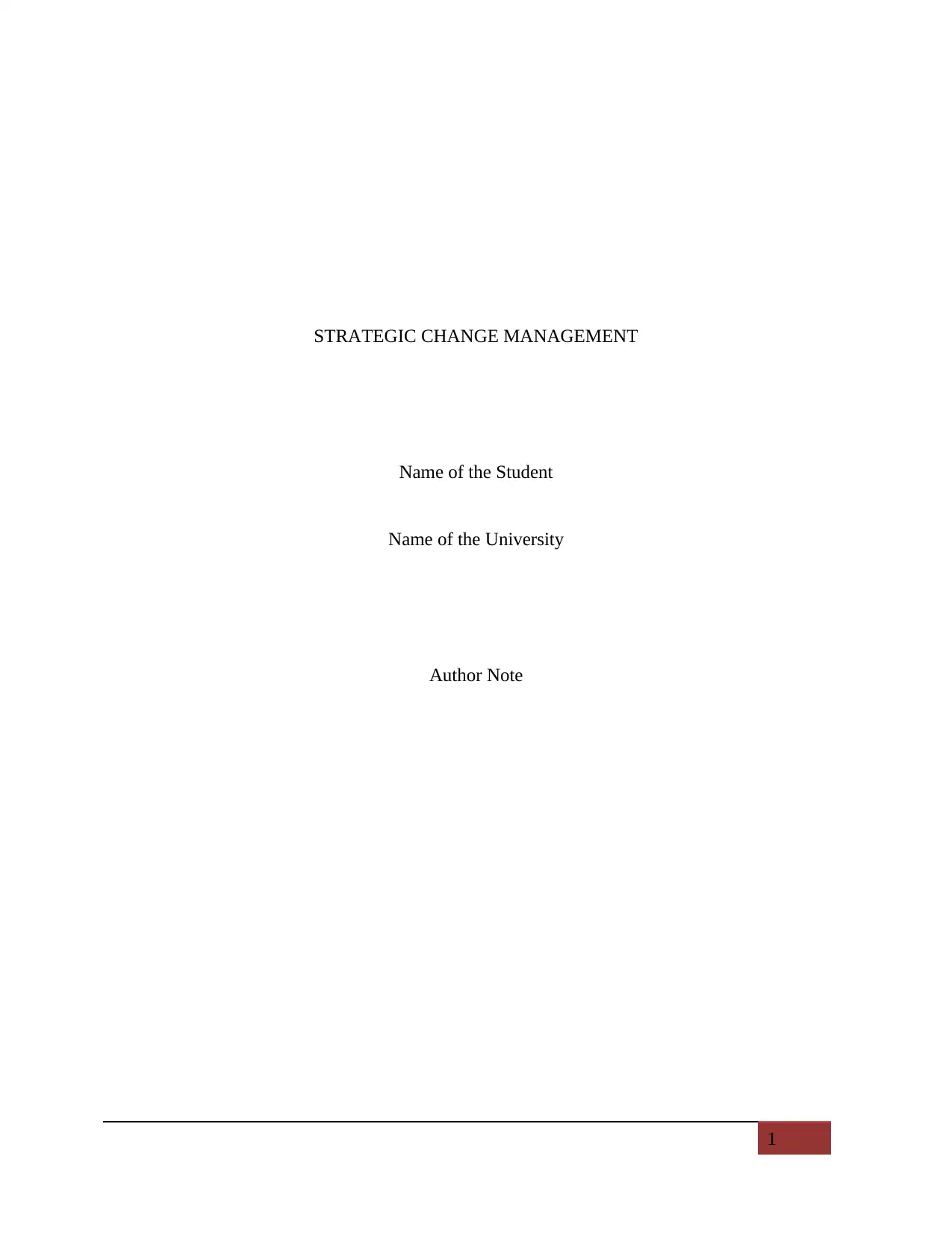
STRATEGIC CHANGE MANAGEMENT
Name of the Student
Name of the University
Author Note
1
Name of the Student
Name of the University
Author Note
1
Paraphrase This Document
Need a fresh take? Get an instant paraphrase of this document with our AI Paraphraser
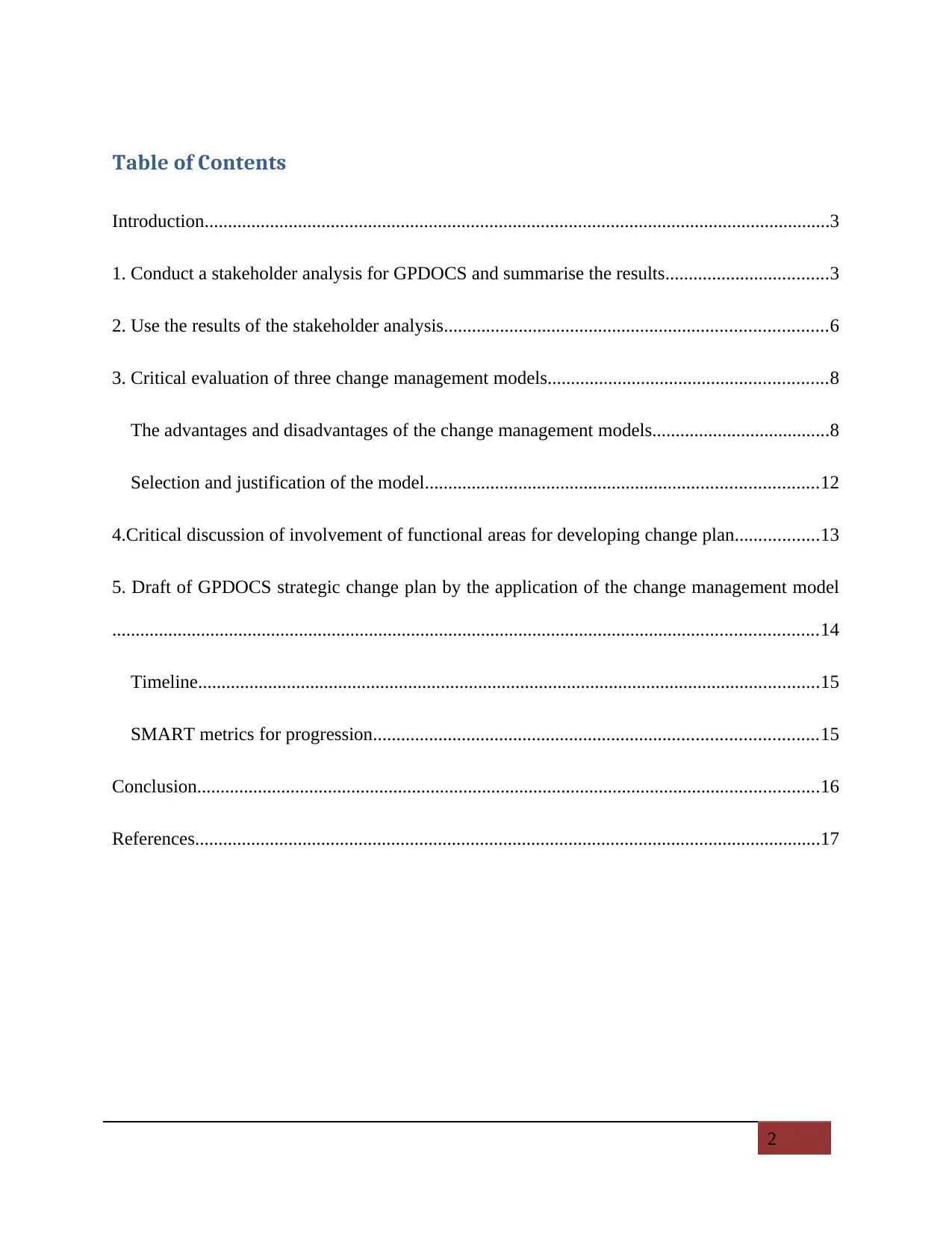
Table of Contents
Introduction......................................................................................................................................3
1. Conduct a stakeholder analysis for GPDOCS and summarise the results...................................3
2. Use the results of the stakeholder analysis..................................................................................6
3. Critical evaluation of three change management models............................................................8
The advantages and disadvantages of the change management models......................................8
Selection and justification of the model....................................................................................12
4.Critical discussion of involvement of functional areas for developing change plan..................13
5. Draft of GPDOCS strategic change plan by the application of the change management model
.......................................................................................................................................................14
Timeline.....................................................................................................................................15
SMART metrics for progression...............................................................................................15
Conclusion.....................................................................................................................................16
References......................................................................................................................................17
2
Introduction......................................................................................................................................3
1. Conduct a stakeholder analysis for GPDOCS and summarise the results...................................3
2. Use the results of the stakeholder analysis..................................................................................6
3. Critical evaluation of three change management models............................................................8
The advantages and disadvantages of the change management models......................................8
Selection and justification of the model....................................................................................12
4.Critical discussion of involvement of functional areas for developing change plan..................13
5. Draft of GPDOCS strategic change plan by the application of the change management model
.......................................................................................................................................................14
Timeline.....................................................................................................................................15
SMART metrics for progression...............................................................................................15
Conclusion.....................................................................................................................................16
References......................................................................................................................................17
2
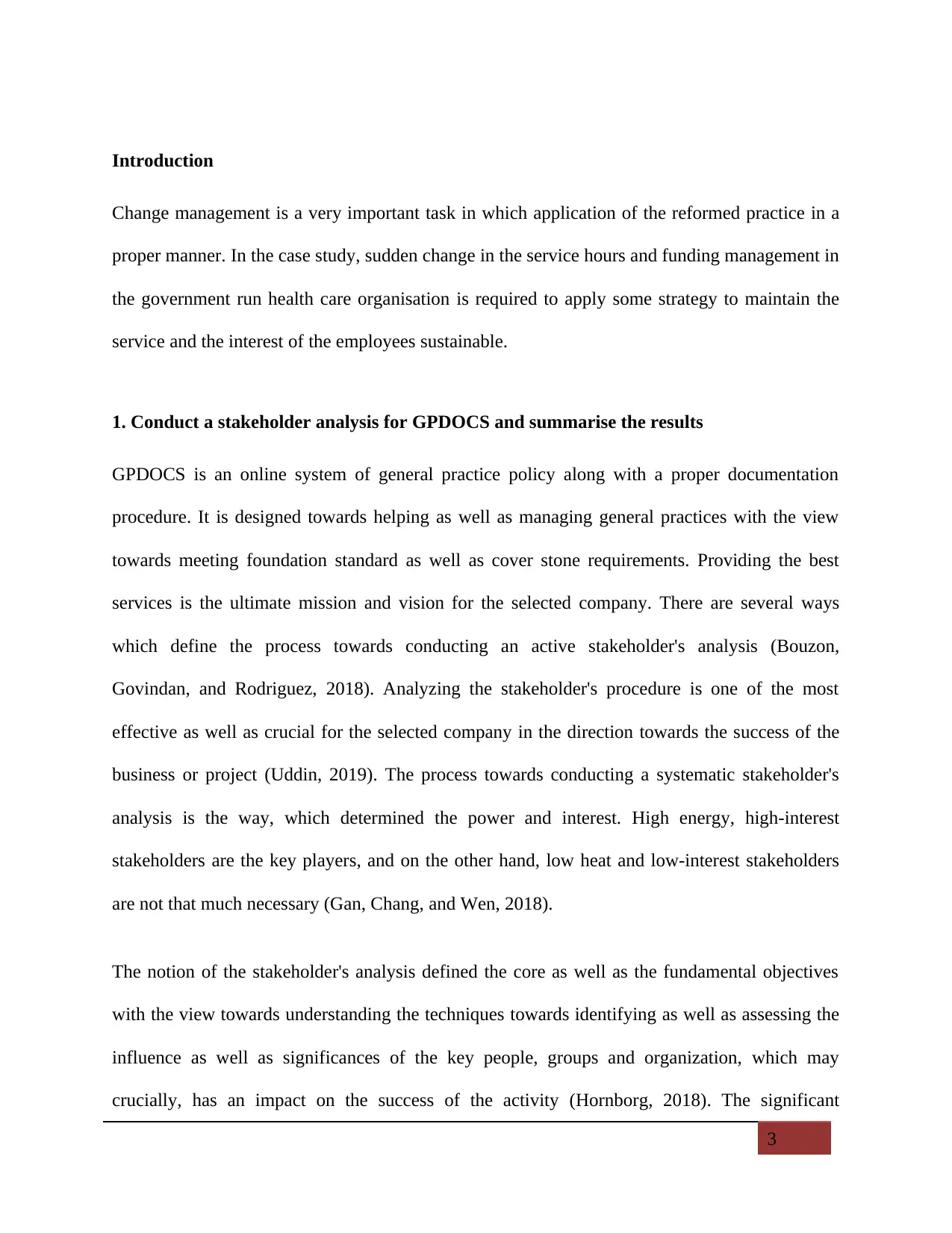
Introduction
Change management is a very important task in which application of the reformed practice in a
proper manner. In the case study, sudden change in the service hours and funding management in
the government run health care organisation is required to apply some strategy to maintain the
service and the interest of the employees sustainable.
1. Conduct a stakeholder analysis for GPDOCS and summarise the results
GPDOCS is an online system of general practice policy along with a proper documentation
procedure. It is designed towards helping as well as managing general practices with the view
towards meeting foundation standard as well as cover stone requirements. Providing the best
services is the ultimate mission and vision for the selected company. There are several ways
which define the process towards conducting an active stakeholder's analysis (Bouzon,
Govindan, and Rodriguez, 2018). Analyzing the stakeholder's procedure is one of the most
effective as well as crucial for the selected company in the direction towards the success of the
business or project (Uddin, 2019). The process towards conducting a systematic stakeholder's
analysis is the way, which determined the power and interest. High energy, high-interest
stakeholders are the key players, and on the other hand, low heat and low-interest stakeholders
are not that much necessary (Gan, Chang, and Wen, 2018).
The notion of the stakeholder's analysis defined the core as well as the fundamental objectives
with the view towards understanding the techniques towards identifying as well as assessing the
influence as well as significances of the key people, groups and organization, which may
crucially, has an impact on the success of the activity (Hornborg, 2018). The significant
3
Change management is a very important task in which application of the reformed practice in a
proper manner. In the case study, sudden change in the service hours and funding management in
the government run health care organisation is required to apply some strategy to maintain the
service and the interest of the employees sustainable.
1. Conduct a stakeholder analysis for GPDOCS and summarise the results
GPDOCS is an online system of general practice policy along with a proper documentation
procedure. It is designed towards helping as well as managing general practices with the view
towards meeting foundation standard as well as cover stone requirements. Providing the best
services is the ultimate mission and vision for the selected company. There are several ways
which define the process towards conducting an active stakeholder's analysis (Bouzon,
Govindan, and Rodriguez, 2018). Analyzing the stakeholder's procedure is one of the most
effective as well as crucial for the selected company in the direction towards the success of the
business or project (Uddin, 2019). The process towards conducting a systematic stakeholder's
analysis is the way, which determined the power and interest. High energy, high-interest
stakeholders are the key players, and on the other hand, low heat and low-interest stakeholders
are not that much necessary (Gan, Chang, and Wen, 2018).
The notion of the stakeholder's analysis defined the core as well as the fundamental objectives
with the view towards understanding the techniques towards identifying as well as assessing the
influence as well as significances of the key people, groups and organization, which may
crucially, has an impact on the success of the activity (Hornborg, 2018). The significant
3
⊘ This is a preview!⊘
Do you want full access?
Subscribe today to unlock all pages.

Trusted by 1+ million students worldwide

stakeholders associated with the overall framework in the healthcare system are patient,
physician, employers, insurance companies' pharmaceutical firms and government. Majorities of
the insurance companies sell health coverage products, directly to the patients or indirectly
through an employee or other government intermediaries (Arena, Bozzolan and Michelon, 2015).
Nevertheless, the classifications of the overall stakeholder's analysis further classified into two
parts, which comprises of the internal analysis followed by the external examination. The
interrelation among the stakeholders in the entire system is very much complicated. The primary
responsibility of any stakeholder is to maximize the wealth associated with the whole
framework. Similarly, the primary goal of the employers is to make money and evaluate their
provisions of health based on the overall duties and responsibilities (Arena, Bozzolan and
Michelon, 2015).
The roles and responsibilities of the stakeholders are different from one another. The purpose of
the internal stakeholders might be different from the part of the external stakeholders (Li,
O’Donnell, García-Castro, and Vega-Sánchez, 2017). Along with the same point of time, it is
very much significant to distinguish the overall roles and responsibilities of both the internal
stakeholders along with the external stakeholders based on the global business operations
associated with the present organizational aspects. Nevertheless, for the discussion, the definition
of the stakeholders comprises the entities that define the overall process involved in the business
operations and affected substantially to the system of the business formations. All the
stakeholders have duties based on the whole process of the business activities and contribute as
one of the vital roles and responsibilities based on the core as well as fundamental actives of the
entire business proceedings (Li, O’Donnell, García-Castro, and Vega-Sánchez, 2017).
Nevertheless based on the current business scenario, it is very much sufficient with the view
4
physician, employers, insurance companies' pharmaceutical firms and government. Majorities of
the insurance companies sell health coverage products, directly to the patients or indirectly
through an employee or other government intermediaries (Arena, Bozzolan and Michelon, 2015).
Nevertheless, the classifications of the overall stakeholder's analysis further classified into two
parts, which comprises of the internal analysis followed by the external examination. The
interrelation among the stakeholders in the entire system is very much complicated. The primary
responsibility of any stakeholder is to maximize the wealth associated with the whole
framework. Similarly, the primary goal of the employers is to make money and evaluate their
provisions of health based on the overall duties and responsibilities (Arena, Bozzolan and
Michelon, 2015).
The roles and responsibilities of the stakeholders are different from one another. The purpose of
the internal stakeholders might be different from the part of the external stakeholders (Li,
O’Donnell, García-Castro, and Vega-Sánchez, 2017). Along with the same point of time, it is
very much significant to distinguish the overall roles and responsibilities of both the internal
stakeholders along with the external stakeholders based on the global business operations
associated with the present organizational aspects. Nevertheless, for the discussion, the definition
of the stakeholders comprises the entities that define the overall process involved in the business
operations and affected substantially to the system of the business formations. All the
stakeholders have duties based on the whole process of the business activities and contribute as
one of the vital roles and responsibilities based on the core as well as fundamental actives of the
entire business proceedings (Li, O’Donnell, García-Castro, and Vega-Sánchez, 2017).
Nevertheless based on the current business scenario, it is very much sufficient with the view
4
Paraphrase This Document
Need a fresh take? Get an instant paraphrase of this document with our AI Paraphraser

towards evolving the process of the potential changes associated with the relevant and outline
and framework of the entire business activities.
Figure 1: Stakeholder map
(Source: Martin and Rice, 2015)
In the given situation of GPDOCS health care organisation the change has been implemented in
the organisational environment that has an impact on the internal stakeholders. Involved service
providers are asked to increase the duty hours and days that become an issue in the organisation.
Therefore through the application of the stakeholder mapping intension of the government and
the employees towards their duty can be identified. Samuel et al. (2015) stated that interest of a
5
and framework of the entire business activities.
Figure 1: Stakeholder map
(Source: Martin and Rice, 2015)
In the given situation of GPDOCS health care organisation the change has been implemented in
the organisational environment that has an impact on the internal stakeholders. Involved service
providers are asked to increase the duty hours and days that become an issue in the organisation.
Therefore through the application of the stakeholder mapping intension of the government and
the employees towards their duty can be identified. Samuel et al. (2015) stated that interest of a
5
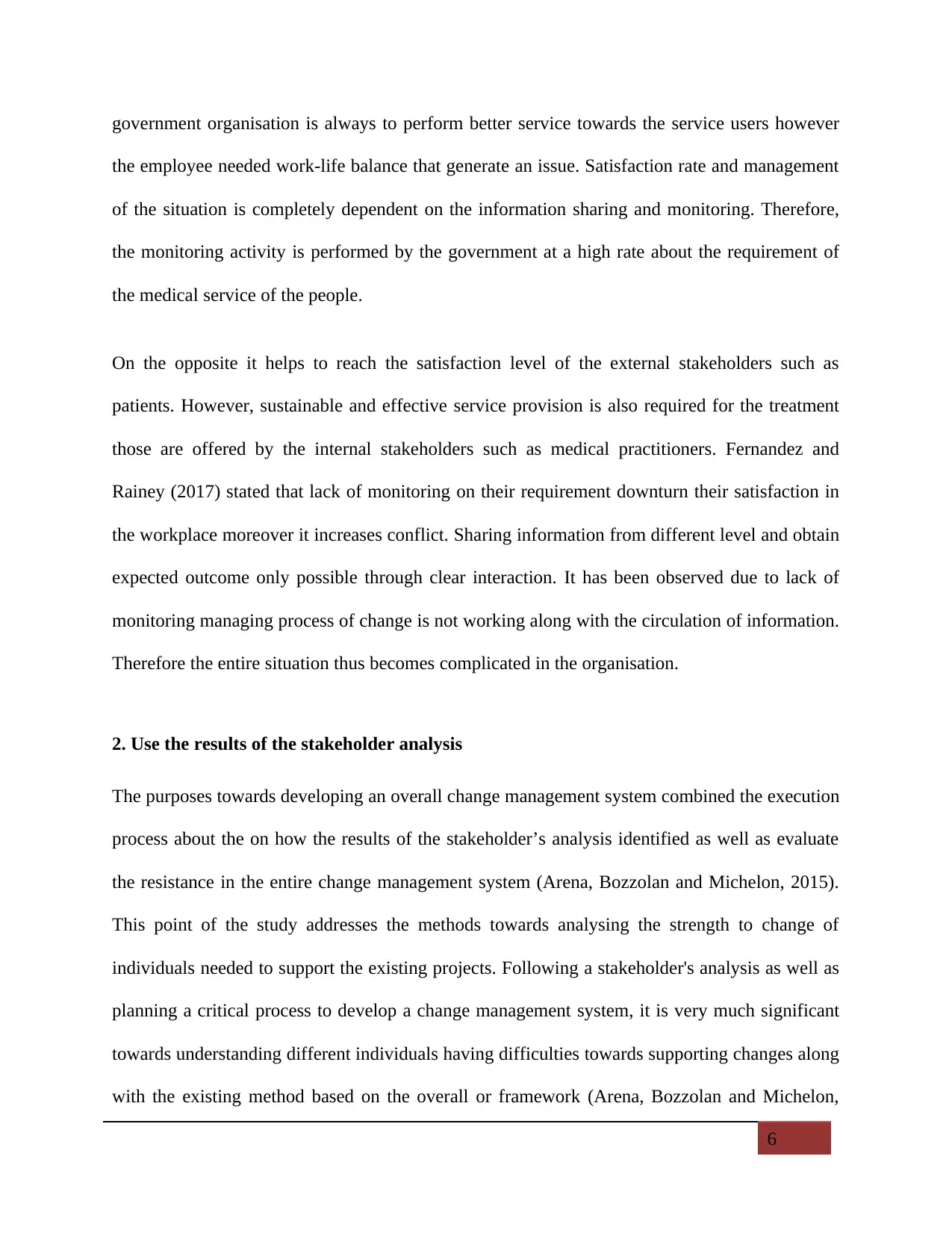
government organisation is always to perform better service towards the service users however
the employee needed work-life balance that generate an issue. Satisfaction rate and management
of the situation is completely dependent on the information sharing and monitoring. Therefore,
the monitoring activity is performed by the government at a high rate about the requirement of
the medical service of the people.
On the opposite it helps to reach the satisfaction level of the external stakeholders such as
patients. However, sustainable and effective service provision is also required for the treatment
those are offered by the internal stakeholders such as medical practitioners. Fernandez and
Rainey (2017) stated that lack of monitoring on their requirement downturn their satisfaction in
the workplace moreover it increases conflict. Sharing information from different level and obtain
expected outcome only possible through clear interaction. It has been observed due to lack of
monitoring managing process of change is not working along with the circulation of information.
Therefore the entire situation thus becomes complicated in the organisation.
2. Use the results of the stakeholder analysis
The purposes towards developing an overall change management system combined the execution
process about the on how the results of the stakeholder’s analysis identified as well as evaluate
the resistance in the entire change management system (Arena, Bozzolan and Michelon, 2015).
This point of the study addresses the methods towards analysing the strength to change of
individuals needed to support the existing projects. Following a stakeholder's analysis as well as
planning a critical process to develop a change management system, it is very much significant
towards understanding different individuals having difficulties towards supporting changes along
with the existing method based on the overall or framework (Arena, Bozzolan and Michelon,
6
the employee needed work-life balance that generate an issue. Satisfaction rate and management
of the situation is completely dependent on the information sharing and monitoring. Therefore,
the monitoring activity is performed by the government at a high rate about the requirement of
the medical service of the people.
On the opposite it helps to reach the satisfaction level of the external stakeholders such as
patients. However, sustainable and effective service provision is also required for the treatment
those are offered by the internal stakeholders such as medical practitioners. Fernandez and
Rainey (2017) stated that lack of monitoring on their requirement downturn their satisfaction in
the workplace moreover it increases conflict. Sharing information from different level and obtain
expected outcome only possible through clear interaction. It has been observed due to lack of
monitoring managing process of change is not working along with the circulation of information.
Therefore the entire situation thus becomes complicated in the organisation.
2. Use the results of the stakeholder analysis
The purposes towards developing an overall change management system combined the execution
process about the on how the results of the stakeholder’s analysis identified as well as evaluate
the resistance in the entire change management system (Arena, Bozzolan and Michelon, 2015).
This point of the study addresses the methods towards analysing the strength to change of
individuals needed to support the existing projects. Following a stakeholder's analysis as well as
planning a critical process to develop a change management system, it is very much significant
towards understanding different individuals having difficulties towards supporting changes along
with the existing method based on the overall or framework (Arena, Bozzolan and Michelon,
6
⊘ This is a preview!⊘
Do you want full access?
Subscribe today to unlock all pages.

Trusted by 1+ million students worldwide
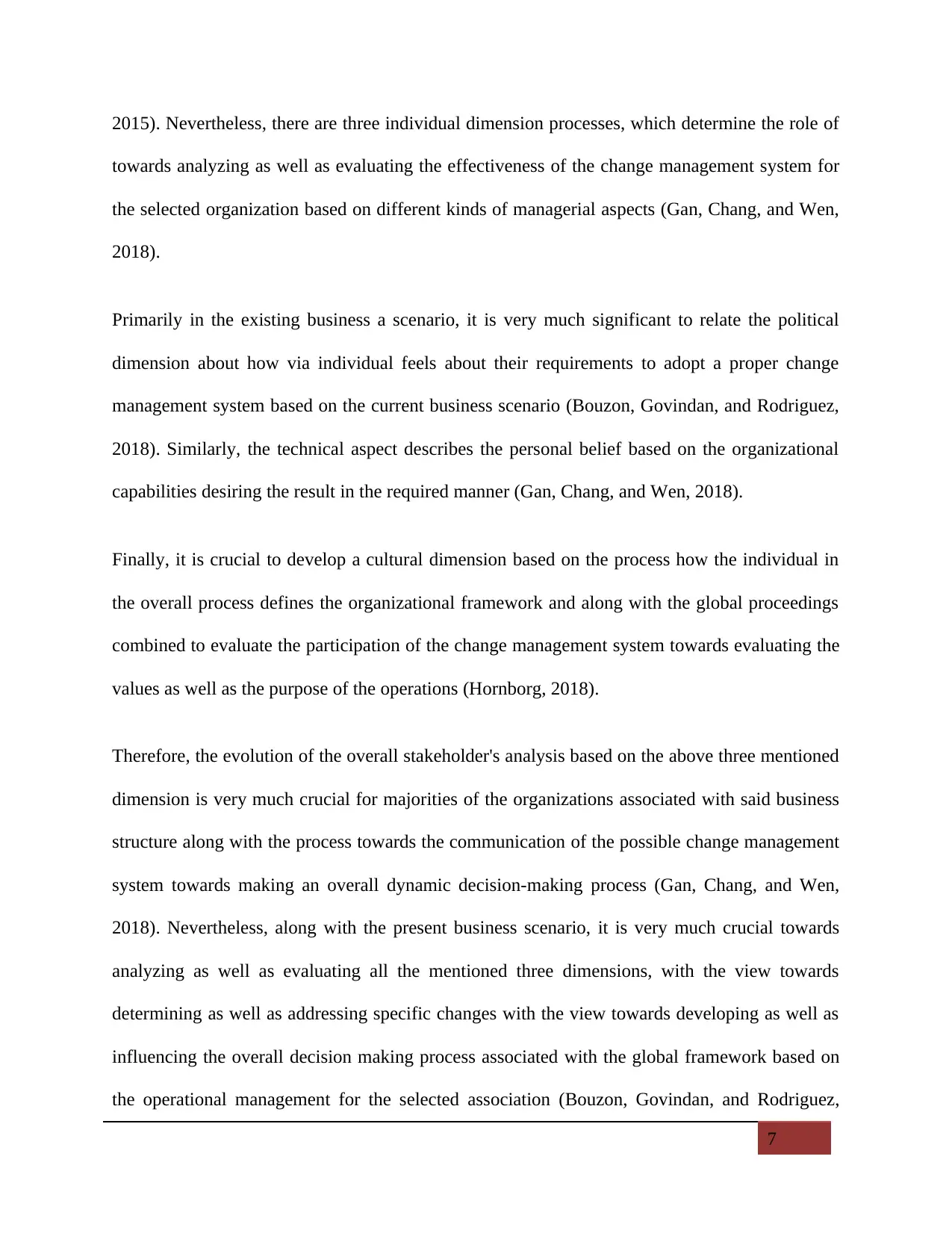
2015). Nevertheless, there are three individual dimension processes, which determine the role of
towards analyzing as well as evaluating the effectiveness of the change management system for
the selected organization based on different kinds of managerial aspects (Gan, Chang, and Wen,
2018).
Primarily in the existing business a scenario, it is very much significant to relate the political
dimension about how via individual feels about their requirements to adopt a proper change
management system based on the current business scenario (Bouzon, Govindan, and Rodriguez,
2018). Similarly, the technical aspect describes the personal belief based on the organizational
capabilities desiring the result in the required manner (Gan, Chang, and Wen, 2018).
Finally, it is crucial to develop a cultural dimension based on the process how the individual in
the overall process defines the organizational framework and along with the global proceedings
combined to evaluate the participation of the change management system towards evaluating the
values as well as the purpose of the operations (Hornborg, 2018).
Therefore, the evolution of the overall stakeholder's analysis based on the above three mentioned
dimension is very much crucial for majorities of the organizations associated with said business
structure along with the process towards the communication of the possible change management
system towards making an overall dynamic decision-making process (Gan, Chang, and Wen,
2018). Nevertheless, along with the present business scenario, it is very much crucial towards
analyzing as well as evaluating all the mentioned three dimensions, with the view towards
determining as well as addressing specific changes with the view towards developing as well as
influencing the overall decision making process associated with the global framework based on
the operational management for the selected association (Bouzon, Govindan, and Rodriguez,
7
towards analyzing as well as evaluating the effectiveness of the change management system for
the selected organization based on different kinds of managerial aspects (Gan, Chang, and Wen,
2018).
Primarily in the existing business a scenario, it is very much significant to relate the political
dimension about how via individual feels about their requirements to adopt a proper change
management system based on the current business scenario (Bouzon, Govindan, and Rodriguez,
2018). Similarly, the technical aspect describes the personal belief based on the organizational
capabilities desiring the result in the required manner (Gan, Chang, and Wen, 2018).
Finally, it is crucial to develop a cultural dimension based on the process how the individual in
the overall process defines the organizational framework and along with the global proceedings
combined to evaluate the participation of the change management system towards evaluating the
values as well as the purpose of the operations (Hornborg, 2018).
Therefore, the evolution of the overall stakeholder's analysis based on the above three mentioned
dimension is very much crucial for majorities of the organizations associated with said business
structure along with the process towards the communication of the possible change management
system towards making an overall dynamic decision-making process (Gan, Chang, and Wen,
2018). Nevertheless, along with the present business scenario, it is very much crucial towards
analyzing as well as evaluating all the mentioned three dimensions, with the view towards
determining as well as addressing specific changes with the view towards developing as well as
influencing the overall decision making process associated with the global framework based on
the operational management for the selected association (Bouzon, Govindan, and Rodriguez,
7
Paraphrase This Document
Need a fresh take? Get an instant paraphrase of this document with our AI Paraphraser
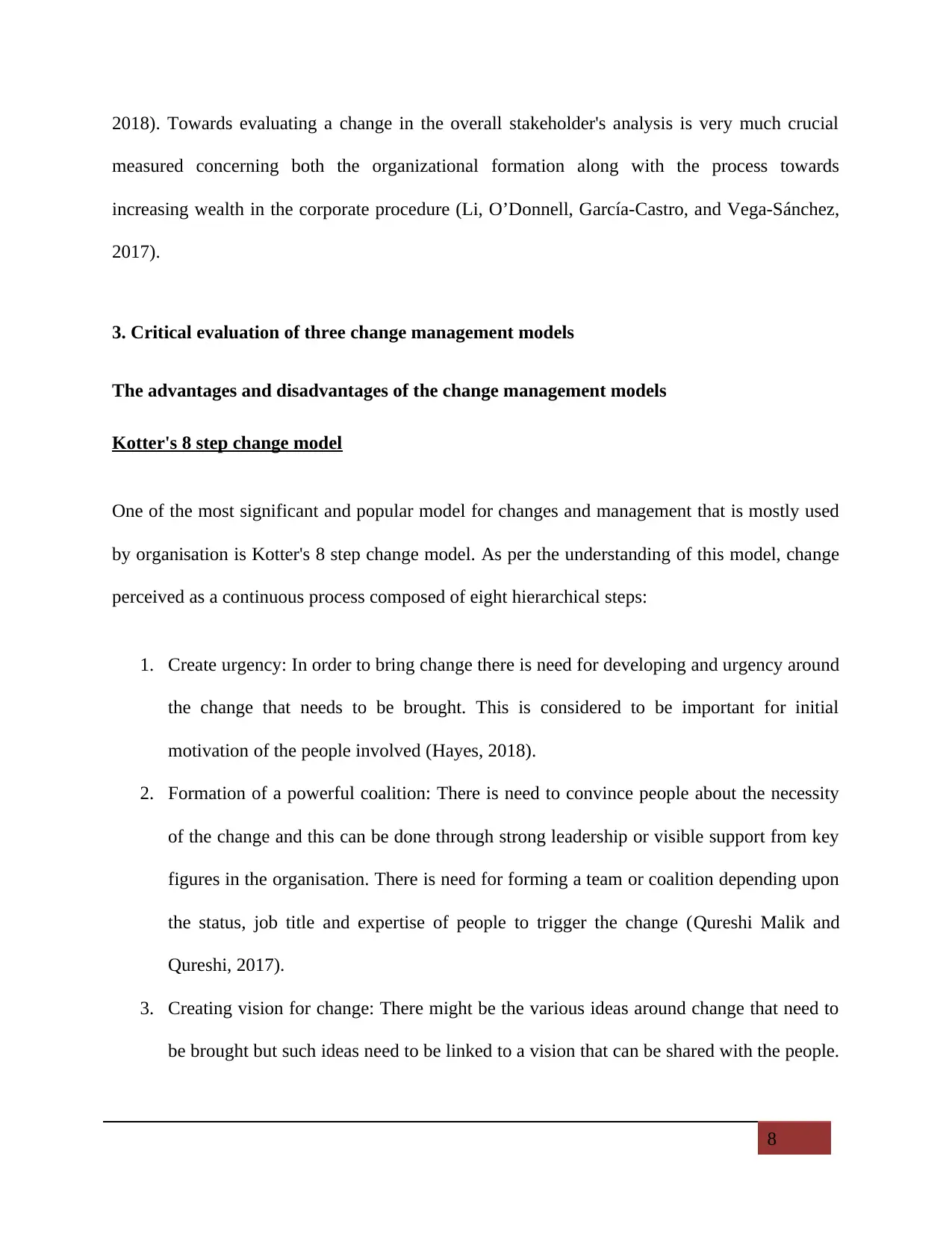
2018). Towards evaluating a change in the overall stakeholder's analysis is very much crucial
measured concerning both the organizational formation along with the process towards
increasing wealth in the corporate procedure (Li, O’Donnell, García-Castro, and Vega-Sánchez,
2017).
3. Critical evaluation of three change management models
The advantages and disadvantages of the change management models
Kotter's 8 step change model
One of the most significant and popular model for changes and management that is mostly used
by organisation is Kotter's 8 step change model. As per the understanding of this model, change
perceived as a continuous process composed of eight hierarchical steps:
1. Create urgency: In order to bring change there is need for developing and urgency around
the change that needs to be brought. This is considered to be important for initial
motivation of the people involved (Hayes, 2018).
2. Formation of a powerful coalition: There is need to convince people about the necessity
of the change and this can be done through strong leadership or visible support from key
figures in the organisation. There is need for forming a team or coalition depending upon
the status, job title and expertise of people to trigger the change (Qureshi Malik and
Qureshi, 2017).
3. Creating vision for change: There might be the various ideas around change that need to
be brought but such ideas need to be linked to a vision that can be shared with the people.
8
measured concerning both the organizational formation along with the process towards
increasing wealth in the corporate procedure (Li, O’Donnell, García-Castro, and Vega-Sánchez,
2017).
3. Critical evaluation of three change management models
The advantages and disadvantages of the change management models
Kotter's 8 step change model
One of the most significant and popular model for changes and management that is mostly used
by organisation is Kotter's 8 step change model. As per the understanding of this model, change
perceived as a continuous process composed of eight hierarchical steps:
1. Create urgency: In order to bring change there is need for developing and urgency around
the change that needs to be brought. This is considered to be important for initial
motivation of the people involved (Hayes, 2018).
2. Formation of a powerful coalition: There is need to convince people about the necessity
of the change and this can be done through strong leadership or visible support from key
figures in the organisation. There is need for forming a team or coalition depending upon
the status, job title and expertise of people to trigger the change (Qureshi Malik and
Qureshi, 2017).
3. Creating vision for change: There might be the various ideas around change that need to
be brought but such ideas need to be linked to a vision that can be shared with the people.
8
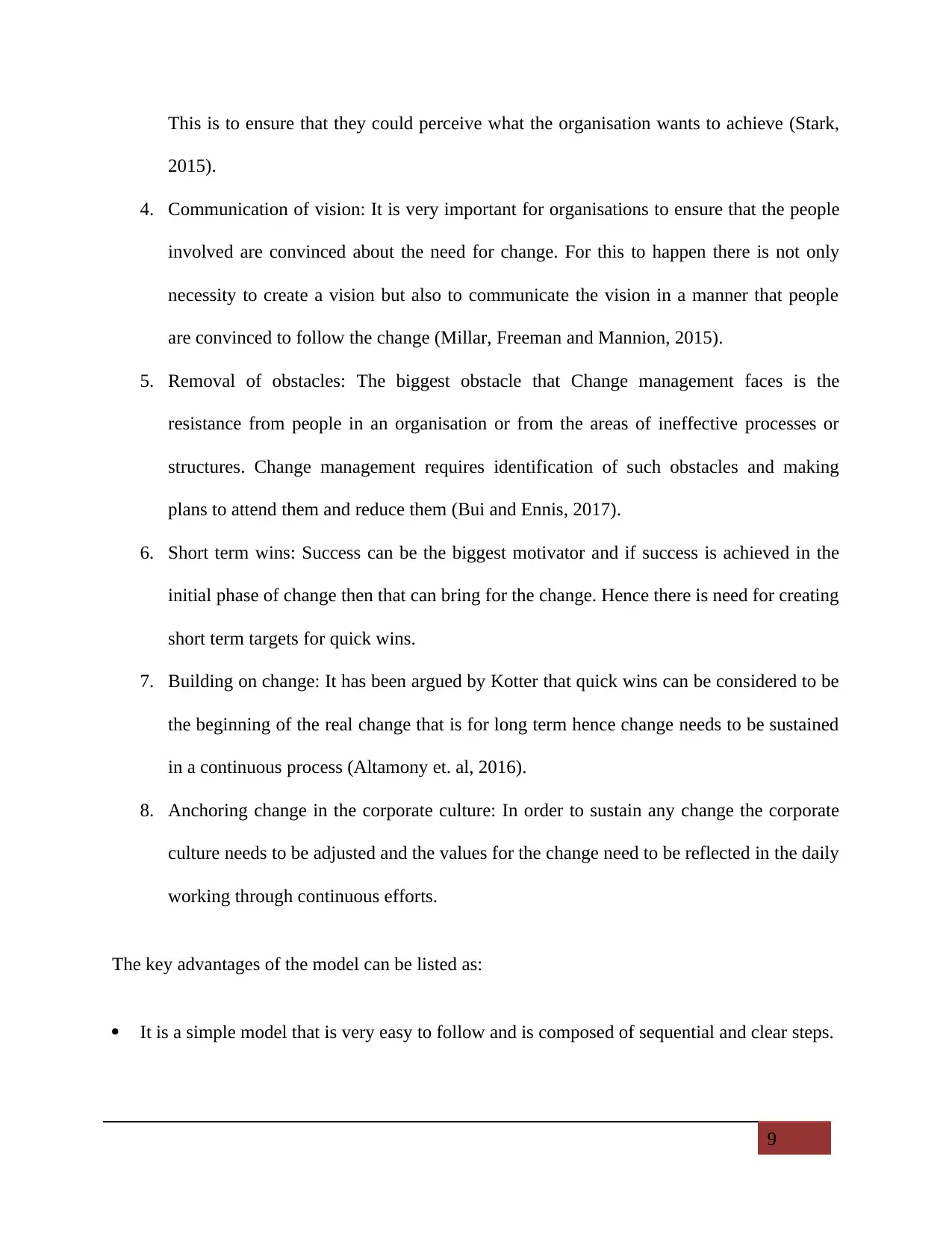
This is to ensure that they could perceive what the organisation wants to achieve (Stark,
2015).
4. Communication of vision: It is very important for organisations to ensure that the people
involved are convinced about the need for change. For this to happen there is not only
necessity to create a vision but also to communicate the vision in a manner that people
are convinced to follow the change (Millar, Freeman and Mannion, 2015).
5. Removal of obstacles: The biggest obstacle that Change management faces is the
resistance from people in an organisation or from the areas of ineffective processes or
structures. Change management requires identification of such obstacles and making
plans to attend them and reduce them (Bui and Ennis, 2017).
6. Short term wins: Success can be the biggest motivator and if success is achieved in the
initial phase of change then that can bring for the change. Hence there is need for creating
short term targets for quick wins.
7. Building on change: It has been argued by Kotter that quick wins can be considered to be
the beginning of the real change that is for long term hence change needs to be sustained
in a continuous process (Altamony et. al, 2016).
8. Anchoring change in the corporate culture: In order to sustain any change the corporate
culture needs to be adjusted and the values for the change need to be reflected in the daily
working through continuous efforts.
The key advantages of the model can be listed as:
It is a simple model that is very easy to follow and is composed of sequential and clear steps.
9
2015).
4. Communication of vision: It is very important for organisations to ensure that the people
involved are convinced about the need for change. For this to happen there is not only
necessity to create a vision but also to communicate the vision in a manner that people
are convinced to follow the change (Millar, Freeman and Mannion, 2015).
5. Removal of obstacles: The biggest obstacle that Change management faces is the
resistance from people in an organisation or from the areas of ineffective processes or
structures. Change management requires identification of such obstacles and making
plans to attend them and reduce them (Bui and Ennis, 2017).
6. Short term wins: Success can be the biggest motivator and if success is achieved in the
initial phase of change then that can bring for the change. Hence there is need for creating
short term targets for quick wins.
7. Building on change: It has been argued by Kotter that quick wins can be considered to be
the beginning of the real change that is for long term hence change needs to be sustained
in a continuous process (Altamony et. al, 2016).
8. Anchoring change in the corporate culture: In order to sustain any change the corporate
culture needs to be adjusted and the values for the change need to be reflected in the daily
working through continuous efforts.
The key advantages of the model can be listed as:
It is a simple model that is very easy to follow and is composed of sequential and clear steps.
9
⊘ This is a preview!⊘
Do you want full access?
Subscribe today to unlock all pages.

Trusted by 1+ million students worldwide

There is easy transition from one step to another and focus on employees for bringing and
sustaining change (Sunder, 2016)
It is well suited for the traditional hierarchies
There also shortcomings of this model that are as follows:
The benefit of the model can be lost if any of the step is missed
It is a long term model and takes time for implementation.
Lewin’s change management model
Lewin’s change management model focuses upon change across three stages: unfreeze, change
and refreeze.
Unfreeze: This is the initial Change management step that the people involved needs to be
prepared for accepting the change that can be done through developing compelling messages.
The purpose of this stage is to create a crisis before the people that can be addressed only
through Change management (Lines et al. 2015).
Change: Once the crisis or uncertainty had been created in the earlier stage, at this stage the
change a transition takes place as people understand and the benefit of change
Refreeze: This stage takes place when the change has been implemented and there is need for
internalising and institutionalizing the changes to ensure long-term stability (Eskerod, Huemann
and Savage, 2015).
The key benefits of the selection of this model are as follows:
It is a simple model to understand and easier to implement as there are only three stages
It is effective for bringing change when there is not much time
The shortcomings of the model also needs to be understood:
10
sustaining change (Sunder, 2016)
It is well suited for the traditional hierarchies
There also shortcomings of this model that are as follows:
The benefit of the model can be lost if any of the step is missed
It is a long term model and takes time for implementation.
Lewin’s change management model
Lewin’s change management model focuses upon change across three stages: unfreeze, change
and refreeze.
Unfreeze: This is the initial Change management step that the people involved needs to be
prepared for accepting the change that can be done through developing compelling messages.
The purpose of this stage is to create a crisis before the people that can be addressed only
through Change management (Lines et al. 2015).
Change: Once the crisis or uncertainty had been created in the earlier stage, at this stage the
change a transition takes place as people understand and the benefit of change
Refreeze: This stage takes place when the change has been implemented and there is need for
internalising and institutionalizing the changes to ensure long-term stability (Eskerod, Huemann
and Savage, 2015).
The key benefits of the selection of this model are as follows:
It is a simple model to understand and easier to implement as there are only three stages
It is effective for bringing change when there is not much time
The shortcomings of the model also needs to be understood:
10
Paraphrase This Document
Need a fresh take? Get an instant paraphrase of this document with our AI Paraphraser
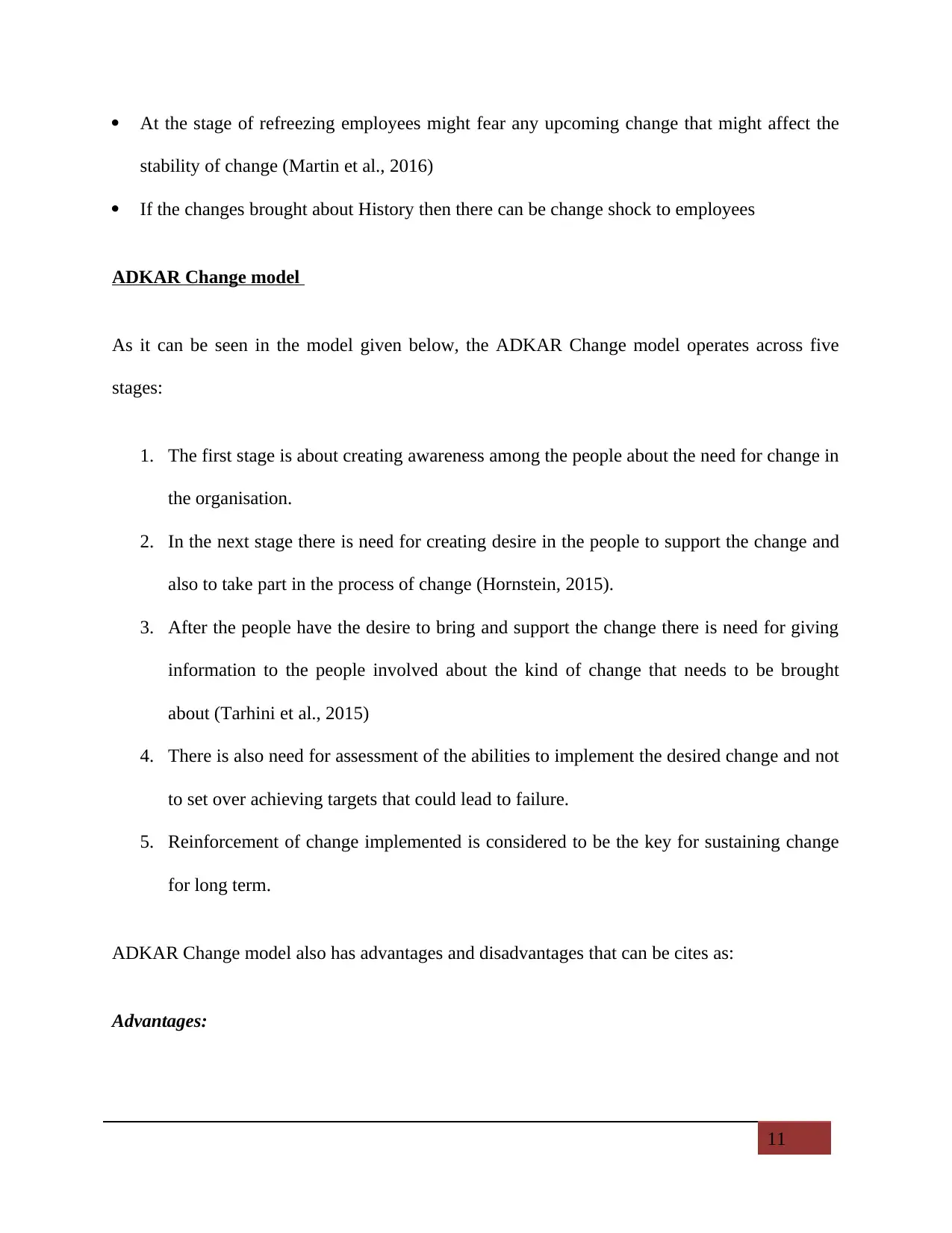
At the stage of refreezing employees might fear any upcoming change that might affect the
stability of change (Martin et al., 2016)
If the changes brought about History then there can be change shock to employees
ADKAR Change model
As it can be seen in the model given below, the ADKAR Change model operates across five
stages:
1. The first stage is about creating awareness among the people about the need for change in
the organisation.
2. In the next stage there is need for creating desire in the people to support the change and
also to take part in the process of change (Hornstein, 2015).
3. After the people have the desire to bring and support the change there is need for giving
information to the people involved about the kind of change that needs to be brought
about (Tarhini et al., 2015)
4. There is also need for assessment of the abilities to implement the desired change and not
to set over achieving targets that could lead to failure.
5. Reinforcement of change implemented is considered to be the key for sustaining change
for long term.
ADKAR Change model also has advantages and disadvantages that can be cites as:
Advantages:
11
stability of change (Martin et al., 2016)
If the changes brought about History then there can be change shock to employees
ADKAR Change model
As it can be seen in the model given below, the ADKAR Change model operates across five
stages:
1. The first stage is about creating awareness among the people about the need for change in
the organisation.
2. In the next stage there is need for creating desire in the people to support the change and
also to take part in the process of change (Hornstein, 2015).
3. After the people have the desire to bring and support the change there is need for giving
information to the people involved about the kind of change that needs to be brought
about (Tarhini et al., 2015)
4. There is also need for assessment of the abilities to implement the desired change and not
to set over achieving targets that could lead to failure.
5. Reinforcement of change implemented is considered to be the key for sustaining change
for long term.
ADKAR Change model also has advantages and disadvantages that can be cites as:
Advantages:
11
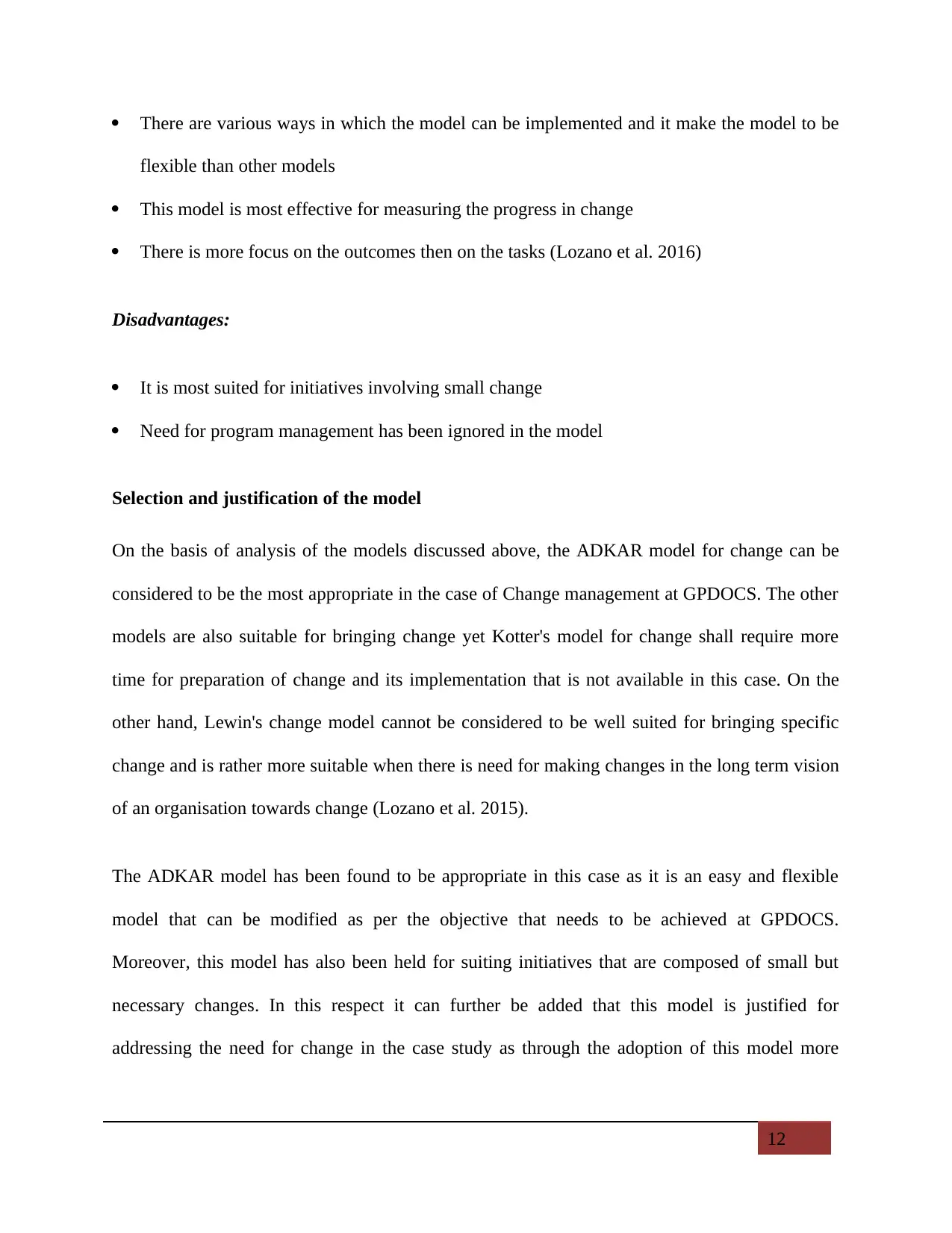
There are various ways in which the model can be implemented and it make the model to be
flexible than other models
This model is most effective for measuring the progress in change
There is more focus on the outcomes then on the tasks (Lozano et al. 2016)
Disadvantages:
It is most suited for initiatives involving small change
Need for program management has been ignored in the model
Selection and justification of the model
On the basis of analysis of the models discussed above, the ADKAR model for change can be
considered to be the most appropriate in the case of Change management at GPDOCS. The other
models are also suitable for bringing change yet Kotter's model for change shall require more
time for preparation of change and its implementation that is not available in this case. On the
other hand, Lewin's change model cannot be considered to be well suited for bringing specific
change and is rather more suitable when there is need for making changes in the long term vision
of an organisation towards change (Lozano et al. 2015).
The ADKAR model has been found to be appropriate in this case as it is an easy and flexible
model that can be modified as per the objective that needs to be achieved at GPDOCS.
Moreover, this model has also been held for suiting initiatives that are composed of small but
necessary changes. In this respect it can further be added that this model is justified for
addressing the need for change in the case study as through the adoption of this model more
12
flexible than other models
This model is most effective for measuring the progress in change
There is more focus on the outcomes then on the tasks (Lozano et al. 2016)
Disadvantages:
It is most suited for initiatives involving small change
Need for program management has been ignored in the model
Selection and justification of the model
On the basis of analysis of the models discussed above, the ADKAR model for change can be
considered to be the most appropriate in the case of Change management at GPDOCS. The other
models are also suitable for bringing change yet Kotter's model for change shall require more
time for preparation of change and its implementation that is not available in this case. On the
other hand, Lewin's change model cannot be considered to be well suited for bringing specific
change and is rather more suitable when there is need for making changes in the long term vision
of an organisation towards change (Lozano et al. 2015).
The ADKAR model has been found to be appropriate in this case as it is an easy and flexible
model that can be modified as per the objective that needs to be achieved at GPDOCS.
Moreover, this model has also been held for suiting initiatives that are composed of small but
necessary changes. In this respect it can further be added that this model is justified for
addressing the need for change in the case study as through the adoption of this model more
12
⊘ This is a preview!⊘
Do you want full access?
Subscribe today to unlock all pages.

Trusted by 1+ million students worldwide
1 out of 22
Related Documents
Your All-in-One AI-Powered Toolkit for Academic Success.
+13062052269
info@desklib.com
Available 24*7 on WhatsApp / Email
![[object Object]](/_next/static/media/star-bottom.7253800d.svg)
Unlock your academic potential
Copyright © 2020–2025 A2Z Services. All Rights Reserved. Developed and managed by ZUCOL.





